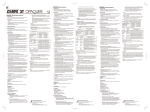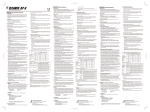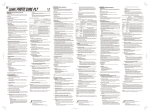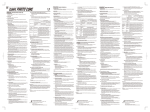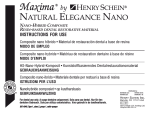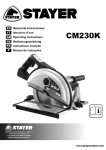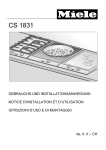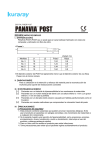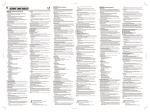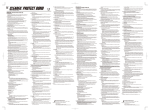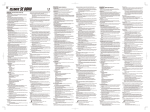Download MODO DE EMPLEO ESPAÑOL MODE D`EMPLOI
Transcript
003 C1721-E21 DENTAL LIGHT- CURED COMPOSITE RESTORATIVE MATERIAL FRANÇAIS MODE D'EMPLOI TM • Silanated colloidal silica • dl-Camphorquinone ENGLISH INSTRUCTIONS FOR USE I. INTRODUCTIONS CLEARFIL AP-X PLT is a light-cured, radiopaque restorative composite resin which provides accurate color-matching, high polishability and excellent physical properties, making it ideal for both anterior and posterior restorations. It is formulated with optimal viscosity assuring easy handling and placement. CLEARFIL AP-X PLT, with the special dispensing system, can be quickly placed directly into the cavity. II. INDICATIONS CLEARFIL AP-X PLT is indicated for the following restorative applications 1. Class I, II, V restorations of posterior teeth 2. Class III, IV, V restorations of anterior teeth 3. Cervical cavities or root surfaces defects III. CONTRAINDICATION Patients with a history of hypersensitivity to methacrylate monomers IV. INCOMPATIBILITY Do not use eugenol-containing materials for pulp protection or temporary sealing since the eugenol could retard the curing process. V. PRECAUTIONS 1. Safety precautions 1. Avoid use of the product for patients with a history of hypersensitivity to methacrylate monomers. 2. If any hypersensitivity, such as a rash or dermatitis, occurs from contact with the product, discontinue the use of the product and consult a physician. 3. Wear gloves or take other appropriate protective measures to prevent the occurrence of hypersensitivity that may result from contact with methacrylate monomers. 4. Use caution to prevent the product from coming in contact with the skin or getting into the eyes. Before using the product, cover the patient's eyes with a towel to protect the patient’s eyes from possible splashing material. 5. If the product comes in contact with human body tissues, take the following actions: <If the product gets in the eyes> Immediately wash the eye with copious amounts of water and consult a physician. <If the product comes in contact with the skin> Immediately wipe the material off using a cotton pledget (or gauze) moistened with alcohol and then wash with copious amounts of water. 6. Use caution to prevent the patient from accidentally swallowing the product. 7. Avoid looking directly at the curing light when curing the product. 8. For infection control reasons, PLT tips are for single use only. 2. Handling and manipulation precautions 1. If necessary, use a rubberdam in order to prevent moisture contamination 2. Do not use the product in conjunction with the other composite resin. Mixing materials may cause a change in physical properties, possibly a decrease, from the properties expected. 3. If the adherent surface extends to uncut enamel, apply a phosphoric acid ething agent (e.g. K-ETCHANT GEL) and leave it in place for 10 seconds before washing and drying. 4. Amalgam or other lining material remaining in the cavity will prevent the passage of light and the polymerization of the product. Completely remove any lining material when preparing the cavity. 5. When light curing the product, note the depth of cure in this Instructions for Use. 6. The emitting tip of the dental curing unit should be held as near and vertical to the resin surface as possible. If a large resin surface is to be light cured, it is advisable to divide the area into several sections and light-cure each section separately. 7. Low light intensity causes poor adhesion. Check the lamp for service life and the dental curing unit guide tip for contamination. It is advisable to check the dental curing light intensity using an appropriate light-evaluating device at appropriate intervals. 8. The paste of the product should be used as soon as practicable after being dispensed from the PLT tip. If the paste is to be left for a while before use, it should be covered with a Light blocking plate. 9. The product should be returned to room temperature before dispensing if it has been taken out of a refrigerator. Failure to do this might cause breakage of the PLT tip. 10. Squeeze the dispenser with a slow, steady pressure. Excessive force is not necessary. 11. The use of the product is restricted to a licensed dental professional. 3. Storage precautions 1. The product must be used by the expiration date indicated on the package. 2. Keep away from extreme heat or direct sunlight. 3. The product must be stored at 2 - 25 °C / 36 - 77 °F when not in use. 4. The product must be stored in proper places where only dental practitioners can access it. VI. SHADES SYSTEM AND COMPONENTS 1. Shades CLEARFIL AP-X PLT is available in 8 shades separately ; 6 shades correspond on a best-match basis with VITA Shade Guide plus 2 shades for special needs. Select an appropriate shade by matching the shade guide to the restoration site. The XL and HO shades offer a strong, lighter white color. The HO shade is translucent white and is suitable for sites requiring extra white color. Standard shades: A2, A3, A3.5, B2, B3 Cervical shades: A4 Translucent shades: XL, HO 2. Components Please see the outside of the package for contents and quantity. 3. Ingredients Principal ingredients; • Bisphenol A diglycidylmethacrylate (Bis-GMA) • Triethyleneglycol dimethacrylate • Silanated barium glass filler • Silanated silica filler The total amount of inorganic filler is approx. 68 vol% The particle size of inorganic fillers ranges from 0,02 to 17 μm. VII. CLINICAL PROCEDURES 1. Cleaning tooth structure Be sure the cavity is adequately cleaned. An adequately cleaned cavity assures maximum adhesive performance. 2. Moisture control Avoid contamination of the treatment area from saliva or blood to produce optimal results. A rubber dam is recommended to keep the tooth clean and dry. 3. Cavity preparations Remove any infected dentin and prepare the cavity in the usual manner. 4. Shade selection Select an appropriate shade using the VITA Lumin-VACUUM shade guide. 5. Pulp protection Any actual or near pulp exposure should be covered with a hard setting calcium hydroxide material. However, usually a cement lining or basing is not necessary. Do not use eugenol materials for pulp protection. 6. Acid etching uncut enamel If the resin restorative material will extend to uncut enamel, apply etching agent (e.g. K-ETCHANT GEL) to the enamel, let it stay for 10 seconds, wash with water, and then dry. [CAUTION] The use of a bonding agent alone does not adequately condition uncut enamel. Overfilling of resin onto unetched, uncut enamel could cause marginal discoloration. 7. Application of bonding agent Tooth surface treatment and bonding should be performed according to Instructions for Use of the bonding system used (e.g. CLEARFIL SE BOND or CLEARFIL TRI-S BOND). 8. Placement and light curing of CLEARFIL AP-X PLT 1) Dispensing Place a PLT tip of the product into the dispenser barrel according to the Instructions for Use for dispenser. The tip may be rotated to provide the proper angle for delivery into the cavity. [CAUTION] Squeeze the dispenser with a slow, steady pressure. Excessive force is not necessary.Discard the tip after use and sterilize the dispenser according to its’ Instructions for Use. 2) Placement Incremental placement and light-curing each increment is strongly recommended especially in deep cavities and in Class II cavities. 3) Curing Light-cure the resin with a dental visible light curing unit* following the table. Hold the light tip as close to the resin as possible. Table: Relation between curing time and depth of cure for each dental curing unit Curing time (sec) Type Conventional halogen* 20 40 5 10 5 10 20 40 Fast halogen* Plasma arc* LED* *Dental curing unit Type Light source Depth of cure (mm) XL, A2, A3, A4, HO A3.5, B2, B3 2.0 2.0 2.0 2.0 2.0 2.5 2.0 2.0 1.5 2.0 1.5 2.0 1.5 2.0 1.5 2.0 Wavelength range and light intensity Conventional Halogen lamp halogen Light intensity2) of 150 – 550 mW/cm2 in wavelength range from 400 – 515 nm Fast halogen Halogen lamp Light intensity2) of more than 550 mW/cm2 in wavelength range from 400 – 515 nm Plasma arc Light intensity3) of more than 2000 mW/cm2 in wavelength range from 400 – 515 nm, and light intensity of more than 450 mW/cm2 in wavelength range from 400 – 430 nm LED Xenon lamp Blue LED1) Light intensity2) of more than 300 mW/cm2 in wavelength range from 400 – 515 nm 1) Peak of emission spectrum: 450 – 480 nm 2) Evaluated according to ISO 10650-1. 3) Wavelength distribution and light intensity values measured with a spectro-radiometer calibrated using an IEC or the NIST (National Institute of Standards and Technology) standard lamp 9. Finishing Contour the restoration and adjust the occlusion and using a fine diamond point. Polish with silicon rubber points or polishing discs. [WARRANTY] Kuraray Noritake Dental Inc. will replace any product that is proved to be defective. Kuraray Noritake Dental Inc. does not accept liability for any loss or damage, direct, consequential or special, arising out of the application or use of or the inability to use these products. Before using, the user shall determine the suitability of the products for the intended use and the user assumes all risk and liability whatsoever in connection therewith. [NOTE] “CLEARFIL”, “CLEARFIL AP-X”, “CLEARFIL TRI-S BOND” and “SE BOND” are trademarks of KURARAY CO., LTD. “VITA” is a trademark of VITA Zahnfabrik, H.Rauter GmbH & Co. KG. 1621 Sakazu, Kurashiki, Okayama 710-0801, Japan Kuraray Europe GmbH Philipp-Reis-Str. 4, 65795 Hattersheim am Main, Germany Phone:+49 (0)69 305 35 840 Fax:+49 (0)69 305 35 640 I. INTRODUCTION CLEARFIL AP-X PLT est une résine composite restauratrice photopolymérisable radio-opaque qui permet une reproduction précise des couleurs et une grande capacité de polissage et qui est dotée de propriétés physiques excellentes, faisant d'elle une résine parfaite pour les restaurations antérieures et postérieures. Sa viscosité optimale garantit une facilité de manipulation et de pose. CLEARFIL AP-X PLT, avec son système de distribution spécial, peut être rapidement déposé directement dans la cavité. II. INDICATIONS CLEARFIL AP-X PLT est préconisé pour les applications de restauration suivantes : 1. Les restaurations de Classe I, II, V des dents postérieures 2. Les restaurations de Classe III, IV, V des dents antérieures 3. Les cavités cervicales ou défauts de la surface de la racine III. CONTRE-INDICATION Patients ayant des antécédents d’hypersensibilité aux monomères de méthacrylate IV. INCOMPATIBILITÉ Ne pas utiliser de matériaux à base d'eugénol pour une protection de la pulpe ou un scellement temporaire, car l'eugénol pourrait retarder le processus de polymérisation. V. PRÉCAUTIONS 1. Mesures de sécurité 1. N’utilisez pas le produit chez les patients présentant une hypersensibilité aux monomères de méthacrylate. 2. Si une hypersensibilité, telle que des rougeurs ou une dermatite, apparaît avec le produit, interrompez l’utilisation du produit et consultez un médecin. 3. Porter des gants ou prendre d’autres mesures appropriées pour empëcher tout problème d'hypersensibilité pouvant résulter d'un contact avec des monomères méthacryliques. 4. Prenez les mesures nécessaires pour éviter que le produit ne soit en contact avec la peau ou les yeux. Avant d’utiliser le produit, protégez les yeux du patient à l’aide d’une serviette afin d’éviter toute projection éventuelle de matériaux. 5. Si le produit entre en contact avec tout tissu humain, procédez comme suit : <Si le produit est en contact avec l’œil> Lavez immédiatement et abondamment l’œil à l’eau et consultez un ophtalmologiste. <Si le produit est en contact avec la peau> Épongez immédiatement avec un tampon de coton (ou de la gaze) imbibé d’alcool, puis rincez abondamment à l’eau. 6. Prenez les mesures nécessaires pour éviter que le patient n’avale accidentellement le produit. 7. Évitez de regarder directement la lampe de polymérisation lorsque vous polymérisez le produit. 8. Afin de contrôler les infections, les embouts PLT sont à usage unique. 2. Précautions relatives à l’utilisation et à la manipulation 1. Si nécessaire, utilisez une digue en caoutchouc afin d’empêcher toute contamination par l’humidité. 2. N'utilisez pas le produit avec d'autres résines composites. Le mélange de matériaux peut modifier les propriétés physiques et éventuellement diminuer les performances escomptées. 3. Si la surface adhérente se propage à de l’émail non altéré, appliquez un agent mordençant à base d'acide phosphorique (par exemple, K-ETCHANT GEL) et laissez le poser pendant 10 secondes avant de rincer et de laisser sécher. 4. L’amalgame ou tout autre matériau de recouvrement resté dans la cavité empêchera le passage de la lumière et la polymérisation du produit. Retirez intégralement tout matériau de recouvrement lors de la préparation de la cavité. 5. Lors de la photopolymérisation du produit, notez la profondeur de la polymérisation dans ce mode d'emploi. 6. La pointe émettrice de l'appareil de polymérisation dentaire doit être maintenue aussi perpendiculaire à la surface de résine et aussi près que possible de la surface de résine. Si la surface de résine à photopolymériser est grande, il est préférable de diviser la zone en plusieurs sections et de photopolymériser chaque section séparément. 7. Si l'intensité de la lumière est trop faible, cela peut entraîner une mauvaise adhérence. Vérifiez la durée de vie de la lampe et examinez la pointe émettrice de l'appareil de polymérisation dentaire afin de vous assurer de l'absence de toute contamination. Il est recommandé de vérifier l'intensité de la lampe de l'appareil de polymérisation à l'aide d'un appareil de mesure de l'intensité approprié à des intervalles réguliers. 8. La pâte du produit doit être utilisée dès que possible une fois extraite de l’embout PLT. Si la pâte doit être laissée de côté pendant un moment avant usage, elle doit être recouverte d’une plaque protectrice contre la lumière. 9. Le produit doit être remis à température ambiante avant d'être appliqué s'il a été placé au réfrigérateur. L’embout PLT risque de se casser si vous omettez cette étape. 10. Appuyez sur le distributeur lentement et de manière constante. Une pression excessive est inutile. 11. Le produit ne peut être utilisé que par un dentiste professionnel autorisé. 3. Précautions de stockage 1. Le produit doit être utilisé avant la date d’expiration indiquée sur l’emballage. 2. Ne pas exposer à une chaleur extrême et aux rayons directs du soleil. 3. Le produit doit être conservé à 2 - 25 °C / 36 - 77 °F lorsqu'il n'est pas utilisé. 4. Le produit doit être stocké dans un lieu prévu à cet effet auquel seuls des dentistes professionnels ont accès. VI. SYSTÈME DE TEINTES ET COMPOSANTS 1. Teintes CLEARFIL AP-X PLT est disponible dans 8 teintes distinctes ; 6 teintes correspondent aux teintes les plus courantes du teintier VITA et 2 teintes pour les besoins spécifiques. Sélectionnez la teinte appropriée en faisant correspondre le teintier au site de restauration. Les teintes XL et HO offrent une couleur blanche vive et plus claire. La teinte HO est un blanc translucide qui s'adapte aux sites nécessitant une couleur extra blanche. Teintes standard : A2, A3, A3.5, B2, B3 Teintes cervicales : A4 Teintes translucides : XL, HO 2. Composants Veuillez vous reporter à l’extérieur de l'emballage pour plus d'informations sur le contenu et les quantités. 3. Ingrédients Ingrédients principaux : • Bisphénol A diglycidyleméthacrylate (Bis-GMA) • Triéthylèneglucol diméthacrylate • Verre de barium silanisé • Matériau de remplissage de silice silanisé • Silice colloïdal silanisé • dl-Quinone camphrée La cantidad total de relleno inorgánico es de aproximadamente 68 vol%. El tamaño de partícula de los rellenos inorgánicos oscila entre 0,02 y 17 μm. ESPAÑOL MODO DE EMPLEO La quantité totale de matériau inorganique de remplissage est d'environ 68 vol% La dimension des particules inorganiques de remplissage va de 0,02 à 17 μm. VII. PROCÉDURES CLINIQUES 1. Nettoyage de la structure de la dent Assurez-vous que la cavité est correctement nettoyée. Une cavité propre garantit une performance d'adhérence optimale. 2. Contrôle de l’humidité Pour des résultats optimaux, évitez toute contamination de la zone de traitement par de la salive ou du sang. Une digue en caoutchouc est recommandée pour garder la dent propre et sèche. 3. Préparation de la cavité Retirez toute dentine infectée et préparez la cavité comme d'habitude. 4. Sélection de la teinte Sélectionnez une teinte appropriée à l’aide du teintier VITA Lumin-VACUUM. 5. Protection pulpaire La pulpe dentaire ou les zones proches de la pulpe dentaire exposées devront être couvertes à l'aide d'un matériau à base d'hydroxyde de calcium de prise dure. Toutefois, généralement, aucun revêtement ou base de ciment n'est nécessaire. N'utilisez pas de matériaux à base d'eugénol pour protéger la pulpe. 6. Mordançage à l’acide de l’émail non altéré Si le matériau à base de résine restauratrice se propage à de l’émail non altéré, appliquez un agent mordançant (par exemple, K-ETCHANT GEL) à l’émail et laissez le poser pendant 10 secondes avant de rincer à l’eau et de laisser sécher. [PRÉCAUTION] L’utilisation d'un seul agent de collage ne conditionne pas proprement l'émail non altéré. Le débordement de la résine sur de l’émail non altéré, non mordancé peut entraîner une décoloration marginale. 7. Application de l’agent de collage Le traitement de la surface de la dent et le collage doivent être effectués conformément au mode d'emploi du système de collage utilisé (par exemple, CLEARFIL SE BOND ou CLEARFIL TRI-S BOND). 8. Pose et photopolymérisation de CLEARFIL AP-X PLT 1) Dispersion Placez un embout PLT du produit dans le tube de distribution conformément au mode d'emploi du distributeur. L’embout peut être pivoté pour déposer le produit dans la cavité dans le bon angle. [PRÉCAUTION] Appuyez sur le distributeur lentement et de manière constante. Une pression excessive est inutile. Jetez l’embout après usage et stérilisez le distributeur conformément au mode d'emploi. 2) Pose La pose incrémentale et la photopolymérisation de chaque incrément sont fortement recommandées, notamment pour les cavités profondes et les cavités de Classe II. 3) Polymérisation Photopolymérisez la résine avec un appareil de photopolymérisation dentaire visible* en fonction du tableau suivant. Maintenez la pointe de la lampe le plus près possible de la résine. Tableau : Correspondance entre le temps de polymérisation et la profondeur de la polymérisation pour chaque appareil de polymérisation dentaire Temps de Profondeur de la polymérisation (mm) polymérisation XL, A2, A3, A4, HO (sec) A3.5, B2, B3 Halogène 20 2,0 1,5 conventionnel* 40 2,0 2,0 5 2,0 1,5 Halogène rapide* 10 2,0 2,0 5 2,0 1,5 Arc de plasma* 10 2,0 2,5 20 2,0 1,5 LED* 40 2,0 2,0 Type *Appareil de polymérisation dentaire Source de Plage de longueurs d’onde et intensité lumineuse lumière Intensité lumineuse2) de 150 – 550 mW/cm2 dans Halogène Lampe conventionnel halogène la plage de longueurs d’onde de 400 – 515 nm Type Halogène rapide Lampe halogène Arc de plasma Intensité lumineuse supérieure à 2000 mW/cm Lampe au dans la plage de longueurs d’onde de 400 – 515 nm et intensité lumineuse supérieure à 450 mW/cm2 xénon dans la plage de longueurs d’onde de 400 – 430 nm LED LED1) bleue Intensité lumineuse2) supérieure à 550 mW/cm2 dans la plage de longueurs d’onde de 400 – 515 nm 3) 2 Intensité lumineuse supérieure à 300 mW/cm dans la plage de longueurs d’onde de 400 – 515 nm 2) 2 1) Spectre des émissions maximales : 450 – 480 nm 2) Évalué conformément à la norme ISO 10650-1. 3) Gamme d’ondes et valeurs de l’intensité lumineuse mesurées avec un spectroradiomètre calibré en utilisant une lampe standard IEC ou la lampe standard du NIST (National Institute of Standards and Technology) 9. Finition Tracez les contours de la restauration et ajustez l’occlusion à l’aide d’une fine pointe diamantée. Polissez avec des pointes en caoutchouc silicone ou des disques à polir. [GARANTIE] Kuraray Noritake Dental Inc. remplacera tout produit manifestement défectueux. Kuraray Noritake Dental Inc. décline toute responsabilité pour toute perte ou dommage, direct ou indirect, résultant de l’application ou utilisation non conforme de ces produits. Avant utilisation, l’utilisateur déterminera si les produits conviennent pour l’utilisation prévue, et l’utilisateur assumera tous les risques et responsabilités découlant de l’utilisation. [NOTA] “CLEARFIL”, “CLEARFIL AP-X”, “CLEARFIL TRI-S BOND” et “SE BOND” sont des marques de KURARAY CO., LTD. “VITA” est une marque de VITA Zahnfabrik, H.Rauter GmbH & Co. KG. 1621 Sakazu, Kurashiki, Okayama 710-0801, Japan Kuraray Europe GmbH Philipp-Reis-Str. 4, 65795 Hattersheim am Main, Germany Phone:+49 (0)69 305 35 840 Fax:+49 (0)69 305 35 640 I. INTRODUCCIÓN CLEARFIL AP-X PLT es una resina compuesta de restauración, fotopolimerizable y radiopaca que ofrece un preciso ajuste de color, gran capacidad de pulido y excelentes propiedades físicas, resultando ideal tanto para restauraciones anteriores como posteriores. Está formulada con una viscosidad óptima que garantiza un sencillo manejo y aplicación. El sistema especial de dispensado de CLEARFIL AP-X PLT permite su aplicación rápida y directa en la cavidad. II. ÁMBITOS DE APLICACIÓN CLEARFIL AP-X PLT está indicada para las siguientes aplicaciones de restauración: 1. Restauraciones de clase I, II, V de dientes posteriores. 2. Restauraciones de clase III, IV, V de dientes anteriores. 3. Cavidades cervicales o defectos en las superficies de las raíces. III. CONTRAINDICACIONES Pacientes con historial de hipersensibilidad a los monómeros de metacrilato IV. INCOMPATIBILIDADES No utilizar materiales que contengan eugenol para la protección de la pulpa o el sellado provisional dado que el eugenol puede retrasar el proceso de polimerización. V. PRECAUCIONES 1. Precauciones de seguridad 1. Evitar utilizar el producto en pacientes con un historial de hipersensibilidad a los monómeros de metacrilato. 2. Si el paciente muestra una reacción de hipersensibilidad por contacto con el producto, como es el caso de una erupción o dermatitis, interrumpir la utilización del mismo y consultar a un médico. 3. Póngase guantes o tome las medidas de protección adecuadas para evitar la aparición de hipersensibilidad que puede resultar del contacto con los monómeros de metacrilato. 4. Tener precaución y evitar el contacto del producto con la piel o los ojos. Antes de utilizar el producto, cubrir los ojos del paciente con una toalla para protegerlos de posibles salpicaduras del material. 5. Adoptar las siguientes medidas si el producto entra en contacto con los tejidos humanos: <Si el producto entra en los ojos> Enjuagar inmediatamente los ojos con abundante agua y consultar a un médico. <Si el producto entra en contacto con la piel> Limpiar inmediatamente con una compresa de algodón (o gasa) humedecida con alcohol y, a continuación, aclarar con abundante agua. 6. Tener precaución para evitar que el paciente trague accidentalmente el producto. 7. Evitar mirar directamente a la luz de polimerización al polimerizar el producto. 8. Las puntas PLT son de un solo uso para evitar infecciones. 2. Precauciones de manejo y manipulación 1. Si es necesario, utilizar un dique de goma para controlar la humedad. 2. No utilizar el producto en combinación con otra resina compuesta. La mezcla de materiales puede provocar un cambio en las propiedades físicas, probablemente una reducción en las propiedades previstas. 3. Si la superficie de adhesión se extiende hasta el esmalte sin cortar, aplicar un agente grabador de ácido fosfórico (por ejemplo, K-ETCHANT GEL) y mantenerlo durante 10 segundos antes de lavar y secar. 4. La amalgama o cualquier otro material restaurador que permanezca en la cavidad evitarán el paso de la luz y la polimerización del producto. Eliminar totalmente cualquier material restaurador al preparar la cavidad. 5. Tener presente la profundidad de polimerización facilitada en las presentes Instrucciones de uso al fotopolimerizar el producto. 6. La punta de emisión de la lámpara de polimerización debe mantenerse lo más próxima y vertical posible con respecto a la superficie de la resina. Si se va a fotopolimerizar una superficie de resina de grandes dimensiones, se recomienda dividir la zona en diversas secciones y fotopolimerizar cada una de ellas por separado. 7. Una baja intensidad de luz provoca una mala adhesión. Comprobar la vida útil de la lámpara y la presencia de contaminación en la punta guía de la misma. Se recomienda controlar la intensidad de luz de la lámpara de polimerización con la periodicidad apropiada sirviéndose de un comprobador de luz adecuado. 8. La pasta del producto debe utilizarse lo antes posible tras dispensarla con la punta PLT. Si la pasta va a permanecer cierto tiempo al descubierto antes de su utilización, deberá cubrirse con una placa opaca. 9. El producto debe alcanzar la temperatura ambiente antes de su dispensado si se ha extraído de un frigorífico. En caso contrario puede producirse la rotura de la punta PLT. 10. Apretar el dispensador aplicando una presión suave y constante. No es necesario aplicar una fuerza excesiva. 11. El producto será utilizado únicamente por un profesional dental autorizado. 3. Precauciones de almacenamiento 1. No utilizar el producto una vez transcurrida la fecha de caducidad indicada en el envase. 2. Mantener alejado de fuentes de calor extremo o de la luz solar directa. 3. Conservar el producto a 2 - 25 °C / 36 - 77 °F cuando no se utilice. 4. El producto debe almacenarse en lugares adecuados donde únicamente los dentistas puedan manipularlo. VI. SISTEMA DE COLORES Y COMPONENTES 1. Colores CLEARFIL AP-X PLT está disponible en 8 colores independientes; 6 colores para obtener la mejor correspondencia con las tonalidades de la Guía de colores VITA y 2 colores para necesidades especiales. Seleccionar un color adecuado haciendo coincidir la guía de colores con la zona de restauración. Los colores XL y HO ofrecen un blanco más intenso y claro. El color HO es de un blanco traslúcido adecuado para aquellas zonas que requieren un tono extrablanco. Colores estándar: A2, A3, A3.5, B2, B3 Colores cervicales: A4 Colores traslúcidos: XL, HO 2. Componentes Consultar el exterior del envase para conocer el contenido y las cantidades. 3. Ingredientes Ingredientes principales: • Diglicidilmetacrilato A bisfenol (Bis-GMA) • Dimetacrilato trietileneglicol • Empaste de vidrio de bario silanado • Empaste de silicio silanado • Silicio coloidal silanado • Alcanforquinona dl VII. PROCEDIMIENTOS CLÍNICOS 1. Limpieza de la estructura del diente Asegurarse de que la cavidad está debidamente limpia. Una cavidad sometida a una limpieza correcta garantiza una máxima adhesión. 2. Control de la humedad Evitar que la zona a tratar se contamine con saliva o sangre para garantizar unos óptimos resultados. Se recomienda el empleo de un dique de goma para mantener el diente limpio y seco. 3. Preparación de la cavidad Retirar la dentina infectada y preparar la cavidad de la forma habitual. 4. Selección del color Seleccionar el color adecuado con la guía de colores VITA Lumin-VACUUM. 5. Protección pulpar Cubrir cualquier zona de exposición de la pulpa o próxima a la misma con un material de hidróxido de calcio de fraguado duro. Normalmente no es necesaria una base o revestimiento de cemento. No utilizar productos que contengan eugenol para la protección de la pulpa. 6. Grabado ácido del esmalte sin cortar Si el material de restauración a base de resina se extiende hasta el esmalte sin cortar, aplicar un agente grabador (por ejemplo, K-ETCHANT GEL) al esmalte, mantener durante 10 segundos, lavar con agua y, a continuación, secar. [PRECAUCIÓN] El uso exclusivo de un agente adhesivo no prepara convenientemente el esmalte sin cortar. El exceso de resina sobre el esmalte sin grabar ni cortar puede provocar decoloración marginal. 7. Aplicación del agente adhesivo El tratamiento de la superficie del diente y la adhesión deben realizarse de conformidad con las Instrucciones de uso del sistema adhesivo utilizado (por ejemplo, CLEARFIL SE BOND o CLEARFIL TRI-S BOND). 8. Aplicación y fotopolimerización de CLEARFIL AP-X PLT 1) Dispensado Colocar una punta PLT del producto en el interior del cilindro distribuidor de acuerdo con las Instrucciones de uso del dispensador. Rotar la punta para obtener el ángulo adecuado para aplicar el producto en la cavidad. [PRECAUCIÓN] Apretar el dispensador aplicando una presión suave y constante. No es necesario aplicar una fuerza excesiva. Desechar la punta después de su utilización y esterilizar el dispensador conforme a sus Instrucciones de uso. 2) Aplicación Se recomienda una técnica de aplicación incremental y la fotopolimerización de cada capa, especialmente en el caso de cavidades profundas y cavidades de Clase II. 3) Polimerización Fotopolimerizar la resina con una de las lámparas de fotopolimerización con luz visible* que figuran en la siguiente tabla. Mantener la punta de emisión de luz lo más cerca posible de la resina. Tabla: Relación entre el tiempo de polimerización y la profundidad de polimerización de cada lámpara de polimerización Tipo Halógena convencional* Halógena rápida* Arco de plasma* LED* Tiempo de polimerización (s) 20 40 5 10 5 10 20 40 Profundidad de polimerización (mm) XL, A2, A3, A4, HO A3.5, B2, B3 2,0 2,0 2,0 2,0 2,0 2,5 2,0 2,0 1,5 2,0 1,5 2,0 1,5 2,0 1,5 2,0 *Lámpara de polimerización Tipo Halógena convencional Halógena rápida Fuente de luz Lámpara halógena Espectro de longitud de onda e intensidad de luz Intensidad de luz2) de 150 – 550 mW/cm2 con un espectro de longitud de onda de 400 – 515 nm Lámpara halógena Intensidad de luz2) superior a 550 mW/cm2 con un espectro de longitud de onda de 400 – 515 nm Arco de plasma Lámpara de xenón Intensidad de luz3) superior a 2000 mW/cm2 con un espectro de longitud de onda de 400 – 515 nm e intensidad de luz superior a 450 mW/cm2 con un espectro de longitud de onda de 400 – 430 nm LED LED1) azul Intensidad de luz2) superior a 300 mW/cm2 con un espectro de longitud de onda de 400 – 515 nm 1) Pico de espectro de emisión: 450 – 480 nm 2) Evaluada conforme a ISO 10650-1. 3) Valores de distribución de longitud de onda e intensidad de luz medidos con un espectroradiómetro calibrado utilizando una lámpara convencional conforme a IEC o NIST (Instituto Nacional de Normas y Tecnología) 9. Acabado Contornear la restauración y ajustar la oclusión con una punta de diamante fina. Pulir con puntas de goma de silicona o discos de pulir. [GARANTÍA] Kuraray Noritake Dental Inc. reemplazará aquellos productos que se demuestre que están defectuosos. Kuraray Noritake Dental Inc. no acepta ninguna responsabilidad por pérdidas o daños, directos, consecuentes o especiales, que se deriven de la aplicación o uso de estos productos o de la imposibilidad para utilizar los mismos. Antes de utilizar los productos, el usuario determinará la idoneidad de los mismos para el fin previsto y asumirá todos los riesgos y responsabilidades en relación con el mismo. [NOTA] “CLEARFIL”, “CLEARFIL AP-X”, “CLEARFIL TRI-S BOND” y “SE BOND” son marcas de KURARAY CO., LTD. “VITA” es una marca de VITA Zahnfabrik, H. Rauter GmbH & Co. KG. 1621 Sakazu, Kurashiki, Okayama 710-0801, Japan Kuraray Europe GmbH Philipp-Reis-Str. 4, 65795 Hattersheim am Main, Germany Phone:+49 (0)69 305 35 840 Fax:+49 (0)69 305 35 640 • Silice colloidale silanizzata • dl-Canforochinone ITALIANO ISTRUZIONI PER L’USO I. INTRODUZIONE CLEARFIL AP-X PLT è una resina composita restaurativa radiopaca fotopolimerizzata che fornisce un preciso processo di correzione colore, un’elevata lucidabilità ed eccellenti proprietà fisiche, rendendola ideale sia per restauri anteriori, sia posteriori. È formulata con una viscosità ottimale che garantisce una manipolazione e una collocazione agevoli. CLEARFIL AP-X PLT, con lo speciale sistema di erogazione può essere collocata rapidamente nella cavità. II. INDICAZIONI CLEARFIL AP-X PLT è indicata per le seguenti applicazioni restaurative: 1. Restauri di denti posteriori di Classe I, II, V 2. Restauri di denti anteriori di Classe III, IV, V 3. Cavità cervicali o difetti delle superfici radicali III. CONTROINDICAZIONI Pazienti con una storia di ipersensibilità verso i monomeri metacrilati IV. INCOMPATIBILITÁ Non usare materiali contenenti eugenolo per la protezione della polpa o per sigillature temporanee, perché l’eugenolo potrebbe ritardare il processo di polimerizzazione. V. PRECAUZIONI 1. Precauzioni di sicurezza 1. Evitare di usare il prodotto su pazienti con una storia di ipersensibilità verso i monomeri metacrilati. 2. Se si manifesta ipersensibilità, con uno sfogo o una dermatite, a causa del contatto con il prodotto, interromperne l’uso del prodotto e consultare un medico. 3. Indossare guanti o prendere appropriate misure protettive per evitare l’insorgere di ipersensibilità che potrebbe derivare dal contatto con i monomeri metacrilati. 4. Prestare attenzione affinché il prodotto non venga a contatto con la pelle o con gli occhi. Prima di utilizzare il prodotto, coprire gli occhi del paziente con un panno e proteggere gli occhi del paziente contro eventuali schizzi di materiale. 5. Se il prodotto viene a contatto con i tessuti del corpo umano, intraprendere le seguenti misure: <Se il prodotto entra negli occhi> Lavare immediatamente l’occhio con abbondante acqua e consultare un medico. <Se il prodotto entra in contatto con la pelle> Rimuovere immediatamente il materiale utilizzando un tampone di cotone (o garza) inumidito con alcol, quindi lavare con abbondante acqua. 6. Prestare la massima attenzione affinché il paziente non rischi di ingoiare accidentalmente il prodotto. 7. Evitare di guardare direttamente l’unità di polimerizzazione, durante il relativo trattamento del prodotto. 8. Per motivi legati al controllo delle infezioni, le punte PLT sono monouso. 2. Precauzioni d'uso e di manipolazione 1. Se necessario, utilizzare una diga in gomma per evitare la contaminazione da umidità. 2. Non utilizzare il prodotto in combinazione con altre resine composite. Una miscela dei materiali potrebbe causare una modifica delle proprietà fisiche, con possibile riduzione delle proprietà attese. 3. Se la superficie di adesione si estende allo smalto non tagliato, applicare un agente mordenzante a base di acido fosforico (ad esempio, K-ETCHANT GEL) e lasciarlo agire per 10 secondi prima di procedere al lavaggio e all’asciugatura. 4. L’amalgama o altro materiale di rivestimento rimasto nella cavità eviterà il passaggio di luce e la polimerizzazione del prodotto. Rimuovere qualsiasi materiale di rivestimento durante la preparazione della cavità. 5. Durante la fotopolimerizzazione del prodotto, rispettare la profondità di polimerizzazione riportata nelle presenti istruzioni d’uso. 6. La punta ad emissione luminosa dell’unità di fotopolimerizzazione deve essere tenuta il più vicino e il più verticale possibile rispetto alla superficie in resina. Se deve fotopolimerizzare una grande superficie in resina, si consiglia di suddividere l’area in diverse sezioni, da fotopolimerizzare ciascuna separatamente. 7. Una bassa intensità luminosa causa una scarsa adesione. Verificare la durata utile della lampadina ed esaminare la punta guida dell’unità di fotopolimerizzazione dentale per eventuali tracce di contaminazione. Si consiglia di controllare regolarmente l’intensità della luce di polimerizzazione dentale utilizzando un appropriato dispositivo di valutazione. 8. La pasta del prodotto deve essere utilizzata entro il più breve tempo possibile dall’erogazione dalla punta PLT. Se la pasta deve essere lasciata ferma prima di essere usata, deve essere coperta adeguatamente con una piastra di protezione contro la luce. 9. Il prodotto deve tornare alla temperatura ambiente prima di essere erogato, se è stato estratto da un frigorifero. In caso contrario si corre il rischio di rottura della punta PLT. 10. Schiacciare il dispenser con una pressione lenta e costante. Non è necessario impiegare eccessiva forza. 11. L'utilizzo del prodotto è riservato esclusivamente a professionisti del settore. 3. Precauzioni di conservazione 1. Usare il prodotto entro la data di scadenza specificata sulla confezione. 2. Tenere lontano da calore estremo e dalla luce solare diretta. 3. Il prodotto deve essere conservato a 2 - 25 °C / 36 - 77 °F se non utilizzato. 4. Il prodotto deve essere conservato in luoghi idonei, cui abbiano accesso esclusivamente professionisti del settore. VI. SISTEMA DI TONALITÀ E COMPONENTI 1. Tonalità CLEARFIL AP-X è disponibile in 8 tonalità separate; 6 tonalità corrispondono su base best-match alla guida delle tonalità VITA più 2 tonalità per necessità particolari. Selezionare la tonalità appropriata confrontando la guida delle tonalità con il sito della restaurazione. Le tonalità XL e HO offrono un forte colore bianco più brillante. La tonalità HO è bianco translucido, idonea per siti che richiedono un colore extra bianco. Tonalità standard: A2, A3, A3.5, B2, B3 Tonalità cervicali: A4 Tonalità translucide: XL, HO La quantità complessiva di filler inorganici è di ca. 68 vol% La dimensione delle particelle dei filler inorganici va da 0,02 a 17 μm. VII. PROCEDURE CLINICHE 1. Pulizia della struttura del dente Accertarsi che la cavità sia adeguatamente pulita. Una cavità adeguatamente pulita garantisce la massima resa di adesione. 2. Controllo dell’umidità Per ottenere i risultati migliori, evitare di contaminare l’area da trattare con saliva o sangue. Per mantenere il dente pulito e asciutto si consiglia l’impiego di una diga in gomma. I. INLEIDING CLEARFIL AP-X PLT is een lichtuithardende, röntgenopake composietkunststof, die een correcte kleurenovereenkomst, uiterst goede polijstbaarheid en uitstekende fysieke eigenschappen mogelijk maakt, waardoor hij ideaal is voor zowel restauraties voor tanden en kiezen. Hij heeft een formule met een optimale viscositeit, die zorgt voor een goede verwerking en plaatsing. CLEARFIL AP-X PLT kan met zijn speciale uitduwsysteem snel en rechtstreeks in de caviteit worden aangebracht. 3. Preparazioni della cavità Rimuovere tutta la dentina infetta e preparare la cavità in base alla consueta procedura. II. INDICATIES CLEARFIL AP-X PLT is aangewezen voor de volgende herstellende toepassingen 1. Klasse I, II, V-restauraties van kiezen 2. Klasse III, IV, V-restauraties van tanden 3. Cervicale caviteiten of defecten van de worteloppervlakken 4. Selezione della tonalità Selezionare una tonalità adeguata utilizzando la guida delle tonalità VITA Lumin-VACUUM. III. TEGENAANGEWEZEN Patiënten met een voorgeschiedenis van overgevoeligheid voor methacrylaatmonomeren 5. Protezione della polpa Ogni area esposta della polpa o nei pressi della polpa deve essere coperta con un materiale a base di idrossido di calcio rigido. Solitamente, non è tuttavia necessario un rivestimento o una base in cemento. Non utilizzare materiali a base di eugenolo per la protezione della polpa. IV. INCOMPATIBILITEIT Geen eugenolhoudende materiaal ter bescherming van de pulpa of het voorlopig verzegelen gebruiken, omdat eugenol het uithardingsproces zou kunnen vertragen. 6. Incisione ad acido su smalto non tagliato Se il materiale restaurativo in resina si estende fino allo smalto non tagliato, applicare un agente mordenzante (ad esempio, K-ETCHANT GEL) sullo smalto, lasciarlo agire per 10 secondi, lavare con acqua e quindi fare asciugare. [ATTENZIONE] L’utilizzo di un agente legante da solo non condiziona adeguatamente lo smalto non tagliato. Una quantità eccessiva di resina sullo smalto non tagliato e non inciso potrebbe causare uno scolorimento marginale. 7. Applicazione di un agente legante Il trattamento della superficie dentale e l’applicazione di agenti leganti devono essere eseguiti in base alle Istruzioni d’uso per il sistema legante utilizzato (ad esempio, CLEARFIL SE BOND o CLEARFIL TRI-S BOND). 8. Collocazione e fotopolimerizzazione di CLEARFIL AP-X PLT 1) Erogazione Collocare una punta PLT del prodotto nel flacone del dispenser in base alle Istruzioni d'uso del dispenser. La punta può essere ruotata per avere l’angolo idoneo di erogazione nella cavità. [ATTENZIONE] Schiacciare il dispenser con una pressione lenta e costante. Non è necessario impiegare eccessiva forza. Smaltire la punta dopo l’uso e sterilizzare il dispenser, in base a quanto descritto nelle Istruzioni d'uso. 2) Collocazione È consigliato procedere per collocazione dei incrementi e fotopolimerizzazione di ogni incremento, specialmente nelle cavità profonde e nelle cavità di Classe II. 3) Polimerizzazione Fotopolimerizzare la resina con un’unità di fotopolimerizzazione dentale* in base a quanto riportato nella tabella. Tenere la punta luminosa il più vicino possibile alla resina. Tabella: Relazione tra il tempo di polimerizzazione e la profondità di polimerizzazione per ogni unità di polimerizzazione dentale Tempo di Profondità di polimerizzazione (mm) XL, A2, A3, Tipo polimerizzazione A4, HO (sec) A3.5, B2, B3 Alogena 20 2,0 1,5 convenzionale* 40 2,0 2,0 5 2,0 1,5 Alogena rapida* 10 2,0 2,0 5 2,0 1,5 Arco al plasma* 10 2,0 2,5 20 2,0 1,5 LED* 40 2,0 2,0 *Unità di fotopolimerizzazione dentale Tipo Fonte luminosa Alogena Lampada convenzionale alogena Gamma lunghezza d’onda e intensità luminosa Intensità luminosa2) di 150 – 550 mW/cm2 nella gamma di lunghezza d’onda 400 – 515 nm Alogena rapida Lampada alogena Arco al plasma Lampada allo xeno Intensità luminosa3) superiore a 2000 mW/cm2 nella gamma di lunghezza d’onda 400 – 515 nm, e intensità luminosa superiore a 450 mW/cm2 nella gamma di lunghezza d’onda 400 – 430 nm LED LED1) blu Intensità luminosa2) superiore a 300 mW/cm2 nella gamma di lunghezza d’onda 400 – 515 nm Intensità luminosa2) superiore a 550 mW/cm2 nella gamma di lunghezza d’onda 400 – 515 nm 1) Picco dello spettro di emissione: 450 – 480 nm 2) Valutazione in conformità con ISO 10650-1. 3) Valori della distribuzione delle lunghezze d’onda e dell’intensità luminosa misurati con uno spettroradiometro tarato utilizzando un lampada standard IEC o NIST (National Institute of Standards and Technology) 9. Rifinitura Rifinire il contorno della restaurazione e regolare l’occlusione utilizzando una punta in diamante fine. Lucidare con punte in gomma siliconica o dischi di lucidatura. [GARANZIA] Kuraray Noritake Dental Inc. sostituirà qualsiasi prodotto rivelatosi difettoso. Kuraray Noritake Dental Inc. non accetta alcuna responsabilità per le perdite o i danni, diretti, conseguenti o speciali derivanti da un’applicazione, dall'uso o dall'incapacità di uso di questi prodotti. Prima dell’uso, l’utente deve determinare l'idoneità dei prodotti allo scopo previsto e l'utente si assume i rischi e la responsabilità a questo collegati. [NOTA] “CLEARFIL”, “CLEARFIL AP-X”, “CLEARFIL TRI-S BOND” e “SE BOND” sono marchi di KURARAY CO., LTD. “VITA” è un marchio di VITA Zahnfabrik, H. Rauter GmbH & Co. KG. V. VOORZORGSMAATREGELEN 1. Veiligheidsmaatregelen 1. Vermijd het product bij patiënten met een gekende voorgeschiedenis van overgevoeligheid voor methacrylaatmonomeren. 2. Indien de patiënt een overgevoeligheidsreactie zoals uitslag of dermatitis vertoont bij contact met het product moet u het gebruik van het product stopzetten en medische hulp inroepen. 3. Draag handschoenen of andere beschermende maatregelen ter voorkoming van hypersensibiliteit als gevolg van contact met methacrylaat-monomeren. 4. Zorg ervoor dat het product niet in contact komt met de huid of in de ogen terechtkomt. Voor het gebruik bedekt u de ogen van de patiënt met een doek om deze te beschermen tegen spatten. 5. Indien het product in contact komt met menselijke lichaamsweefsels, moet u de volgende stappen ondernemen: <Indien het product in de ogen terechtkomt> Onmiddellijk de ogen met overvloedig veel water spelen en een arts raadplegen. <Indien het product in contact met de huid komt> Onmiddellijk het materiaal wegvegen met een wattenschijfje (of gaas), bevochtigd met alcohol, en vervolgens overvloedig spoelen met water. 6. Wees voorzichtig om te voorkomen dat de patiënt het product per ongeluk inslikt. 7. Tijdens het uitharden van het product niet rechtstreeks in het polymerisatieapparaat kijken. 8. Om infecties te vermijden zijn de PLT-toppen enkel bedoeld voor eenmalig gebruik. 2. Voorzorgen voor verwerking en manipulatie 1. Indien nodig moet u een cofferdam gebruiken om te voorkomen dat er een contaminatie met vocht optreedt. 2. Gebruik het product niet samen met andere komposietkunststoffen. Het mengen van materialen kan veranderingen van de fysieke eigenschappen veroorzaken, die mogelijk afbreuk doet aan de verwachte eigenschappen. 3. Indien het hechtoppervlak zich uitbreidt tot ongesneden email, breng een fosforzuur-etsmiddel (bijv. K-ETCHANT GEL) aan en laat het gedurende 10 seconden ter plaatse voor u spoelt en droogt. 4. Amalgama of andere onderlagen die in de caviteit achterblijven, verhinderen het doordringen van licht en dus de polymerisatie van het product. Verwijder eventuele onderlagen volledig wanneer u de caviteit voorbereidt. 5. Waneer u het product met licht behandelt, moet u in deze gebruiksinformatie de uithardingsdiepte nalezen. 6. De uitgifteopening van het polymerisatieapparaat moet zo dicht en verticaal mogelijk tegen het kunststofoppervlak worden geplaatst. Indien een groot kunststofoppervlak moet worden behandeld met licht is het aangewezen het gebied in verschillende secties te verdelen en de secties afzonderlijk met licht te behandelen. 7. Een lage lichtintensiteit veroorzaakt een slechte hechting. Controleer de levensduur van de lamp en de uitgifteopening van het polymerisatieapparaat op contaminatie. Het is aangewezen om regelmatig de lichtintensiteit van het polymerisatieapparaat te controleren met een aangepast toestel voor lichtbeoordeling. 8. De productpasta moet zo snel mogelijk na het uitduwen uit de PLT-top worden gebruikt. Indien de pasta even moet rusten, moet hij worden bedekt met een plaat die het licht blokkeert. 9. Het product moet voor het uitduwen terug op kamertemperatuur worden gebracht indien hij uit een koelkast werd gehaald. Als u dit niet doet, kan de PLT-top breken. 10. Druk op de dispenser met een trage, gelijkmatige druk. U hoeft niet overdreven veel kracht uit te oefenen. 11. Het gebruik van het product is voorbehouden aan gediplomeerde tandheelkundigen. 3. Voorzorgsmaatregelen voor bewaring 1. Het product moet gebruikt worden voor de vervaldatum op de verpakking. 2. Houd uit de buurt van extreme warmte of rechtstreeks zonlicht. 3. Het product moet bewaard worden bij 2 - 25 °C / 36 - 77 °F wanneer het niet gebruikt wordt. 4. Het product moet worden bewaard op de juiste plaats, waar enkel tandartsen er toegang toe hebben. VI. SYSTEEM VOOR KLEUREN EN COMPONENTEN 1. Kleuren CLEARFIL AP-X PLT is beschikbaar in 8 verschillende kleuren; 6 van die kleuren komen overeen met een ideale overeenkomst in de VITA kleurengids en dan zijn er nog 2 kleuren voor specifieke toepassingen. Selecteer de gewenste kleur door de restauratieplaats te vergelijken met de kleurengids. De XL en HO-kleuren bieden een intensere, lichtere wit kleur. De HO-kleur is een doorschijnend wit en is geschikt voor plaatsen waar een extra witte kleur vereist is. Standaardkleuren: A2, A3, A3.5, B2, B3 Cervicale kleuren: A4 Doorschijnende kleuren: XL, HO 2. Componenten Lees de buitenkant van de verpakking voor de inhoud en hoeveelheid. 2. Componenti Si prega di guardare l’esterno della confezione per verificare contenuti e quantità. 3. Ingredienti Ingredienti principali; • Bisfenolo A diglicidilmetacrilato (Bis-GMA) • Trietileneglicoldimetacrilato • Riempitivo in vetro di bario silanizzato • Riempitivo in silice silanizzata NEDERLANDS GEBRUIKSAANWIJZING 1621 Sakazu, Kurashiki, Okayama 710-0801, Japan Kuraray Europe GmbH Philipp-Reis-Str. 4, 65795 Hattersheim am Main, Germany Phone:+49 (0)69 305 35 840 Fax:+49 (0)69 305 35 640 3. Ingrediënten Belangrijkste ingrediënten; • Bisphenol A diglycidylmethacrylaat (Bis-GMA) • Triethyleneglycol dimethacrylaat • Gesilaneerd barium glas-vuller DEUTSCH GEBRAUCHSANWEISUNG • Gesilaneerd silica-vuller • Gesilaneerd colloïdaal silica • dl-Camphorquinone De totale hoeveelheid anorgane vuller bedraagt ong. 68 vol% De partikelgrootte van anorgane vullers varieert van 0,02 tot 17 μm. VII. KLINISCHE PROCEDURES 1. Reinigen van de tandstructuur Zorg ervoor dat de caviteit goed gereinigd is. Een goed gereinigde caviteit zorgt voor een maximale hechting. 2. Vochtcontrole Vermijd contaminatie van het behandelingsgebied met speeksel of bloed voor optimale resultaten. Een cofferdam is aanbevolen om de tand schoon en droog te houden. 3. Voorbereiding van de caviteit Verwijder eventuele geïnfecteerde dentine en bereid de caviteit op de gewoonlijke manier voor. 4. Keuze van de kleur Kies een gepaste kleur aan de hand van de VITA Lumin-VACUUM-kleurengids. 5. Pulpbescherming Elke directe of indirecte pulpaexpositie moet met een vast uithardend calcium-hydroxidemateriaal worden afgedekt. Een cementlaag of -basis is meestal echter niet nodig. Gebruik geen eugenolmaterialen voor pulpbescherming. 6. Zuuretsen ongesneden email Verontreinigingen op ongesneden email door het kunststofmateriaal kunt u het beste verwijderen door het aanbrengen van een etsmiddel (bijv. K-ETCHANT GEL) op het email, laat deze stof gedurende 10 seconden ter plaatse, spoel met water en droog vervolgens. [OPGELET] Het gebruik van enkel een hechtingsmiddel is geen voldoende voorbereiding van ongescneden email. Het overmatig vullen van kunststof op ongeëtst, ongesneden email kan een randverkleuring veroorzaken. 7. Aanbrening van hechtingsmiddel De behandeling van het tandoppervlak en de hechting moeten worden uitgevoerd volgens de gebruiksinformatie van het gebruikte hechtingssysteem (bijv. CLEARFIL SE BOND of CLEARFIL TRI-S BOND). 8. Plaatsing en lichtbehandeling van CLEARFIL AP-X PLT 1) Uitduwen Plaats een PLT-top van het product in een uitduwhouder volgens de gebruiksinformatie van de dispenser. De top kan worden gedraaid tot de juiste hoek om in de caviteit aan te brengen. [OPGELET] Druk op de dispenser met een trage, gelijkmatige druk. Er is geen overdreven kracht nodig. Gooi de top weg na gebruik en steriliseer de dispenser volgens de gebruiksinformatie. 2) Plaatsing De geleidelijke plaatsing en lichtbehandeling van elke laag wordt sterk aanbevolen, vooral bij diepe caviteiten en voor caviteiten van categorie II. 3) Uitharden Uithard de kunststof met licht met een tandbehandelingseenheid* volgens de tabel. Houdt de uitgifteopening zo dicht mogelijk bij de kunststof. Tabel: Verhouding tussen de uithardingstijd en uithardingsdiepte, afhankelijk van de polymerisatielamp Uithardingstijd (sec) Type Conventionele halogeen* Snelle halogeen* 20 40 5 10 5 10 20 40 Plasmaboog* LED* *Polymerisatielamp Type Lichtbron Uithardingsdiepte (mm) XL, A2, A3, A4, HO A3.5, B2, B3 2,0 1,5 2,0 2,0 2,0 1,5 2,0 2,0 2,0 1,5 2,0 2,5 2,0 1,5 2,0 2,0 Golflengte en lichtintensiteit Conventionele Halogeenlamp Lichtintensiteit2) van 150 – 550 mW/cm2 in een golflengtebereik van 400 – 515 nm halogeen Snelle halogeen 2) 2 Halogeenlamp Lichtintensiteit van meer dan 550 mW/cm in een golflengtebereik van 400 – 515 nm Plasmaboog Xenonlamp Lichtintensiteit3) van meer dan 2000 mW/cm2 in een golflengtebereik van 400 – 515 nm, en een lichtintensiteit van meer dan 450 mW/cm2 in een golflengtebereik van 400 – 430 nm LED Blauw LED1) Lichtintensiteit2) van meer dan 300 mW/cm2 in een golflengtebereik van 400 – 515 nm 1) Piek van emissiespectrum: 450 – 480 nm 2) Beoordeeld volgens ISO 10650-1. 3) Golflengte verdeling en lichtintensiteit worden gemeten met een spectroradiometer, die werd gekalibreerd met een IEC of de NIST (National Institute of Standards and Technology)-standaardlamp 9. Afwerking Ga langs de rand van de restauratie en pas de occlusie aan met een fijne diamantpunt. Polijst met silicone rubberen punten of polijstschijven. [GARANTIE] Kuraray Noritake Dental Inc. vervangt eventuele producten die defect blijken te zijn. Kuraray Noritake Dental Inc. aanvaardt geen aansprakelijkheid voor rechtstreekse, resulterende of bijzondere verliezen of schade die voortvloeien uit de toepassing of het gebruik of het onvermogen om deze producten te gebruiken. Voor het gebruik moet de gebruiker de geschiktheid van de producten voor het bedoelde gebruik beoordelen en de gebruiker aanvaardt alle risico's en aansprakelijkheid van welke aard dan ook in verband hiermee. [OPMERKING] “CLEARFIL”, “CLEARFIL AP-X”, “CLEARFIL TRI-S BOND” en “SE BOND” zijn handelsmerken van KURARAY CO., LTD. “VITA” is een handelsmerk van VITA Zahnfabrik, H.Rauter GmbH & Co. KG. 1621 Sakazu, Kurashiki, Okayama 710-0801, Japan Kuraray Europe GmbH Philipp-Reis-Str. 4, 65795 Hattersheim am Main, Germany Phone:+49 (0)69 305 35 840 Fax:+49 (0)69 305 35 640 I. EINLEITUNG CLEARFIL AP-X PLT ist ein lichthärtender, radioopaker Kompositkunststoff für die Restauration, der exakte Farbanpassung, exzellente Polierbarkeit und hervorragende physikalische Eigenschaften bietet und somit für Restaurationen im Frontzahnbereich und Seitenzahnbereich ideal geeignet ist. Seine optimale Viskosität gewährleistet eine einfache Handhabung und Positionierung. CLEARFIL AP-X PLT kann mit dem speziellen Dispensersystem schnell direkt in die Kavität eingebracht werden. II. INDIKATIONEN CLEARFIL AP-X PLT ist für folgende Anwendungen im Rahmen der Restauration geeignet: 1. Im Seitenzahnbereich für Restaurationen der Klasse I, II, V 2. Im Vorderzahnbereich für Restaurationen der Klasse III, IV, V 3. Zervikale Kavitäten oder Defekte der Wurzeloberfläche III. KONTRAINDIKATIONEN Patienten mit bekannter Überempfindlichkeit gegen Methacrylatmonomere IV. UNVERTRÄGLICHKEIT Verwenden Sie keine eugenolhaltigen Materialien für Pulpaschutz oder provisorische Versiegelung, da das Eugenol den Aushärtungsprozess verzögern könnte. V. VORSICHTSMASSNAHMEN 1. Sicherheitshinweise 1. Verzichten Sie bei Patienten mit bekannter Überempfindlichkeit gegen Methacrylatmonomere auf die Anwendung des Produkts. 2. Bei Anzeichen von Überempfindlichkeit, z.B. Hautausschlag oder Hautentzündungen, infolge eines Kontakts mit dem Produkt das Produkt nicht weiter verwenden und einen Arzt konsultieren. 3. Handschuhe tragen oder andere geeignete Maßnahmen zum Schutz vor allergischen Reaktionen treffen, die durch Kontakt mit Methacrylatmonomeren auftreten können. 4. Achten Sie darauf, dass das Produkt nicht auf die Haut oder in die Augen gelangt. Decken Sie vor der Anwendung des Produkts die Augen des Patienten mit einem Tuch ab, um die Augen vor Spritzern des Materials zu schützen. 5. Wenn das Produkt mit menschlichem Gewebe in Kontakt kommt, sind folgende Maßnahmen zu ergreifen: <Wenn das Produkt in die Augen gerät> Die Augen sofort mit reichlich Wasser ausspülen und einen Augenarzt konsultieren. <Wenn das Produkt in Kontakt mit der Haut gerät> Das Material sofort mit einem mit Alkohol befeuchteten Wattebausch (oder Gaze) entfernen und anschließend mit reichlich Wasser spülen. 6. Achten Sie darauf, dass der Patient das Produkt nicht versehentlich verschluckt. 7. Schauen Sie beim Aushärten des Produkts nicht direkt in die Lichtquelle. 8. Aus Gründen der Infektionskontrolle sind PLT-Spitzen ausschließlich für den Einmalgebrauch bestimmt. 2. Sicherheitshinweise für die Handhabung und Verarbeitung 1. Verwenden Sie ggf. einen Kofferdam, um eine Verunreinigung durch Feuchtigkeit zu vermeiden. 2. Benutzen Sie dieses Produkt nicht zusammen mit anderen Kompositkunststoffen. Das Mischen der Materialien kann zu einer Veränderung der physikalischen Eigenschaften, ggf. einer Minderung der erwarteten Eigenschaften, führen. 3. Wenn die Haftfläche sich bis zu ungeschliffenem Zahnschmelz ausdehnt, tragen Sie ein Phosphorsäure-Ätzmittel (z.B. K-ETCHANT GEL) auf und lassen Sie das Mittel 10 Sekunden einwirken. Den Bereich danach abwaschen und trocknen. 4. Amalgam oder andere Beschichtungsmaterialien, die in der Kavität verbleiben, stören die Durchlässigkeit des Lichts und die Polymerisation des Produkts. Bei der Vorbereitung der Kavität sind deshalb alle Beschichtungsmaterialien vollständig zu entfernen. 5. Beachten Sie bei der Lichthärtung des Produkts die in dieser Gebrauchsinformation aufgeführte Lichthärtungstiefe. 6. Die Austrittsöffnung der Polymerisationslampe muss so nah und senkrecht wie möglich an die Kunststoffoberfläche gebracht werden. Wenn eine große Kunststoffoberfläche lichtgehärtet werden soll, sollte der Bereich in mehrere Abschnitte unterteilt und jeder Abschnitt separat lichtgehärtet werden. 7. Geringe Lichtintensität führt zu schlechter Haftung. Überprüfen Sie regelmäßig die Leistung und Funktion der Lampe und kontrollieren Sie die Lichtaustrittsöffnung der dentalen Polymerisationslampe auf Verschmutzungen. Darüber hinaus empfiehlt es sich, regelmäßig die Lichtintensität der dentalen Polymerisationslampe mit Hilfe eines Geräts zur Lichtmessung zu überprüfen. 8. Die Produktpaste muss nach dem Ausbringen aus der PLT-Spitze so schnell wie möglich verarbeitet werden. Wenn die Paste nicht sofort angewendet wird, muss sie mit einer Lichtabdeckung abgedeckt werden. 9. Wenn das Produkt dem Kühlschrank entnommen wurde, muss es vor dem Ausbringen auf Raumtemperatur gebracht werden. Ansonsten kann dies zum Brechen der PLT-Spitze führen. 10. Den Dispenser langsam und mit gleichmäßigen Druck zusammenpressen. Es ist kein übermäßiger Kraftaufwand erforderlich. 11. Dieses Produkt darf nur von zugelassenen Zahnärzten angewendet werden. 3. Sicherheitshinweise für die Lagerung 1. Das Produkt nach Ablauf des auf der Verpackung angegebenen Verfallsdatums nicht mehr anwenden. 2. Schützen Sie das Produkt vor extremer Hitze oder direkter Sonneneinstrahlung. 3. Das Produkt muss bei 2 - 25 °C / 36 - 77 °F gelagert werden, wenn es nicht benutzt wird. 4. Das Produkt muss an geeigneten Plätzen gelagert werden, wo es nur für Zahnärzte zugänglich ist. VI. FARBSYSTEM UND KOMPONENTEN 1. Farben CLEARFIL AP-X PLT ist in 8 verschiedenen Farben erhältlich. 6 Farben basieren auf dem VITA-Farbring mit Best-Match-System, während für spezielle Anforderungen 2 Farben zur Verfügung stehen. Wählen Sie eine passende Farbe aus, indem Sie den Farbring an den Bereich der Restauration halten. Die XL- und HO-Farben bieten eine kräftige, hellere weiße Farbe. Die HO-Farbe ist transluzent weiß und eignet sich für Bereiche, in denen eine besonders weiße Farbe nötig ist. Standardfarben: A2, A3, A3.5, B2, B3 Zervikale Farben: A4 Transluzente Farben: XL, HO 2. Komponenten Inhalt und Mengen sind auf der Außenseite der Verpackung angegeben. 3. Inhaltsstoffe Hauptinhaltsstoffe: • Bisphenol A Diglycidylmethacrylat (Bis-GMA) • Triethyleneglycol-Dimethacrylat • Silanisiertes Bariumglas-Füllmittel • Silanierter Kieselerdefüller • Silanisierte und kolloidale Kieselerde • dl-Kampferchinon Die Gesamtmenge des anorganischen Füllers liegt bei ungefähr 68 vol%. Die Partikelgröße der anorganischen Füller reicht von 0,02 bis 17 μm. VII. KLINISCHE VERFAHREN 1. Reinigung der Zahnstruktur Sorgen Sie für eine angemessene Reinigung der Kavität. Eine angemessen gereinigte Kavität gewährleistet eine maximale Haftleistung. 2. Feuchtigkeitskontrolle Für optimale Ergebnisse müssen Sie darauf achten, dass der Behandlungsbereich nicht durch Speichel oder Blut verunreinigt wird. Es empfiehlt sich, einen Kofferdam zu verwenden, um den Zahn sauber und trocken zu halten. 3. Vorbereitung der Kavität Entfernen Sie infiziertes Dentin und bereiten Sie die Kavität in der üblichen Form vor. 4. Auswahl der Farbe Wählen Sie mit Hilfe des VITA Lumin-VACUUM-Farbrings eine passende Farbe aus. 5. Schutz der Pulpa Freigelegte Pulpa oder pulpennahe Bereiche müssen mit einem fest abbindenden Kalziumhydroxid-Material abgedeckt werden. Eine Zementunterfüllung oder ein Liner ist jedoch nicht erforderlich. Verwenden Sie keine eugenolhaltigen Materialien für den Pulpenschutz. 6. Säureätzung von ungeschliffenem Zahnschmelz Wenn der Restaurationskunststoff sich bis zu ungeschliffenem Zahnschmelz ausdehnt, bringen Sie ein Ätzmittel (z.B. K-ETCHANT GEL) auf den Zahnschmelz auf. Lassen Sie das Mittel 10 Sekunden einwirken. Den Bereich mit Wasser spülen und anschließend trocknen. [VORSICHT] Die Anwendung eines Haftvermittlers allein ist keine ausreichende Vorbereitung des ungeschliffenen Zahnschmelzes. Wenn zu viel Kunststoff auf nicht geätzten, ungeschliffenen Zahnschmelz aufgetragen wird, kann dies zu Verfärbungen im Randbereich führen. 7. Aufbringen des Haftvermittlers Die Behandlung der Zahnoberfläche und das Auftragen des Haftvermittlers sollten gemäß der Gebrauchsinformation des verwendeten Bonding-Systems (z.B. CLEARFIL SE BOND oder CLEARFIL TRI-S BOND) durchgeführt werden. 8. Auftragen und Lichthärten von CLEARFIL AP-X PLT 1) Ausbringen Halten Sie eine PLT-Spitze des Produkts unter Befolgung der Gebrauchsinformation des Dispensers in das Gefäß des Dispensers. Die Spitze kann so gedreht werden, dass sie sich in einem angemessenen Winkel für das Auftragen in der Kavität befindet. [VORSICHT] Den Dispenser langsam und mit gleichmäßigen Druck zusammenpressen. Es ist kein übermäßiger Kraftaufwand erforderlich. Entsorgen Sie die Spitze nach dem Gebrauch und sterilisieren Sie den Dispenser unter Befolgung der Gebrauchsinformation des Dispensers. 2) Auftragen Bei tiefen Kavitäten und Kavitäten der Klasse II ist ein schichtweises Auftragen und Lichthärten der einzelnen Schichten dringend angeraten. 3) Aushärten Lichthärten Sie den Kunststoff mit einer dentalen Polymerisationslampe* und befolgen Sie dabei die Vorgaben der Tabelle. Halten Sie die Spitze der Lampe so nah wie möglich an den Kunststoff. Tabelle: Verhältnis von Polymerisationsdauer und -tiefe für die einzelnen dentalen Polymerisationslampen Polymerisationsdauer (Sek.) Typ Konventionelles Halogen* Schnelles Halogen* Plasmabogen* LED* 20 40 5 10 5 10 20 40 *Dentale Polymerisationslampe Typ Lichtquelle Polymerisationstiefe (mm) XL, A2, A3, A4, HO A3.5, B2, B3 2,0 1,5 2,0 2,0 2,0 1,5 2,0 2,0 1,5 2,0 2,0 2,5 1,5 2,0 2,0 2,0 Wellenlängenbereich und Lichtintensität Konventionelles Halogenlampe Halogen Lichtintensität2) von 150 – 550 mW/cm2 bei einem Wellenlängenbereich von 400 – 515 nm Schnelles Halogen Halogenlampe Lichtintensität2) von über 550 mW/cm2 bei einem Wellenlängenbereich von 400 – 515 nm Plasmabogen Xenonlampe Lichtintensität3) von über 2000 mW/cm2 bei einem Wellenlängenbereich von 400 – 515 nm und Lichtintensität von über 450 mW/cm2 bei einem Wellenlängenbereich von 400 – 430 nm LED Blaue LED1) Lichtintensität2) von über 300 mW/cm2 bei einem Wellenlängenbereich von 400 – 515 nm 1) Spitzenwerte des Emissionsspektrums: 450 – 480 nm 2) Ausgewertet gemäß ISO 10650-1. 3) Die Werte für die Wellenlängenverteilung und die Lichtintensität wurden durch einen kalibrierten Spektrometer mit Hilfe einer IEC- oder NIST-Standardlampe (National Institute of Standards and Technology) ermittelt 9. Finieren Konturieren Sie die Restauration und passen Sie die Okklusion mit Hilfe einer feinen Diamantspitze an. Verwenden Sie zum Polieren Spitzen aus Silikongummi oder Polierscheiben. [GARANTIE] Kuraray Noritake Dental Inc. ersetzt alle nachweislich fehlerhaften Produkte. Kuraray Noritake Dental Inc. übernimmt keine Haftung für unmittelbare, mittelbare oder spezielle Verluste oder Schäden, die sich aus der Anwendung oder dem Gebrauch bzw. einem nicht möglichen Einsatz der Produkte ergeben. Der Anwender hat vor dem Einsatz der Produkte ihre Eignung für den geplanten Verwendungszweck zu prüfen und trägt alle damit verbundenen Haftungsrisiken. [HINWEIS] “CLEARFIL”, “CLEARFIL AP-X”, “CLEARFIL TRI-S BOND” und “SE BOND” sind Warenzeichen von KURARAY CO., LTD. “VITA” ist ein Warenzeichen von VITA Zahnfabrik, H.Rauter GmbH & Co. KG. 1621 Sakazu, Kurashiki, Okayama 710-0801, Japan Kuraray Europe GmbH Philipp-Reis-Str. 4, 65795 Hattersheim am Main, Germany Phone:+49 (0)69 305 35 840 Fax:+49 (0)69 305 35 640 11/2011


